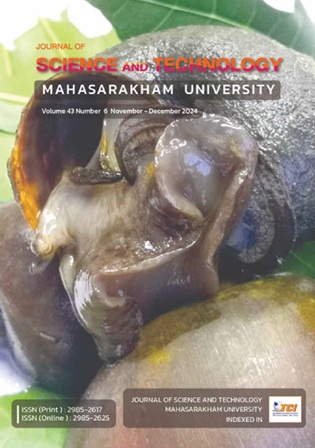Market basket analysis using association rules and its applications
Main Article Content
Abstract
Currently, many tourists in Thailand often discover a local product called One Tambon One Product (OTOP) during their travels. The problem is that tourists have difficulty determining which products are best-selling and suitable for use as their preferred item packages from the hundreds of available options. This is why association rule learning is needed to explore the correlation information and sales transaction patterns for OTOP items that are most frequently sold as product pairs. Our research aims to analyze the frequency of the most popular item sets from sales data in OTOP and to compare the performance of the Frequent Pattern Growth (FP-Growth) algorithm and the Apriori algorithm for OTOP recommendations. We used two datasets from Peanut House and the Nan OTOP Center, covering the years 2016 to 2022, with a total of 200,000 records for the experiment. This study aims to compare the performance of the Apriori and FP-Growth algorithms. The execution time of the Apriori algorithm outperformed that of the FP-Growth method. Overall, user satisfaction with the recommended system is rated very high, at 4.72.
Article Details
References
Aldino, A. A., Pratiwi, E. D., Sintaro, S., & Putra, A. D. (2021, October). Comparison of market basket analysis to determine consumer purchasing patterns using fp-growth and apriori algorithm. In 2021 International Conference on Computer Science, Information Technology, and Electrical Engineering (ICOMITEE) (pp. 29-34). IEEE.
Agrawal, R., Imieliński, T., & Swami, A. (1993, June). Mining association rules between sets of items in large databases. In Proceedings of the 1993 ACM SIGMOD international conference on Management of data (pp. 207-216).
Al-Maolegi, M., & Arkok, B. (2014). An improved Apriori algorithm for association rules. arXiv preprint arXiv:1403.3948.
Fadillah, A. R., Yulita, I. N., Pradana, A., & Suryani, M. (2021, October). Data Mining Implementation Using Frequent Pattern Growth on Transaction Data for Determining Cross-selling and Up-selling (Case Study: Cascara Coffee). In 2021 International Conference
on Artificial Intelligence and Big Data Analytics (pp. 1-6). IEEE.
Fatoni, C. S., Utami, E., & Wibowo, F. W. (2018, December). Online store product recommendation system uses apriori method. In Journal of Physics: Conference Series (Vol. 1140, No. 1, p. 012034). IOP Publishing.
Goebel, V. (2014). Knowledge Discovery in Databases (KDD) and Data Mining (DM). University of Oslo. Department of Informatics.
Hossain, M., Sattar, A. S., & Paul, M. K. (2019, December). Market basket analysis using apriori and FP growth algorithm. In 2019 22nd international conference on computer and information technology (ICCIT) (pp. 1-6). IEEE.
Ketui, N., Wisomka, W., & Homjun, K. (2019). Association rule mining with permutation for estimating students’ performance and its smart education system. Journal of Computers, 30(2), 93-102.
Liu, B., Hsu, W., & Ma, Y. (1998, August). Integrating classification and association rule mining. In Proceedings of the fourth international conference on knowledge discovery and data mining (pp. 80-86).
Li, H., Wang, Y., Zhang, D., Zhang, M., & Chang, E. Y. (2008, October). Pfp: parallel fp-growth for query recommendation. In Proceedings of the 2008 ACM conference on Recommender systems (pp. 107-114).
Patil, M., & Patil, T. (2022). Apriori Algorithm against Fp Growth Algorithm: A Comparative Study of Data Mining Algorithms. Available at SSRN 4113695.
Singh, P. K., Sinha, M., Das, S., & Choudhury, P. (2020). Enhancing recommendation accuracy of item-based collaborative filtering using Bhattacharyya coefficient and most similar item. Applied Intelligence, 50, 4708-4731.
Tareq, S. U., Noor, M. H., & Bepery, C. (2020). Framework of dynamic recommendation system for e-shopping. International Journal of Information Technology, 12(1), 135-140.
Yuan, X. (2017, March). An improved Apriori algorithm for mining association rules. In AIP conference proceedings (Vol. 1820, No. 1). AIP Publishing.

